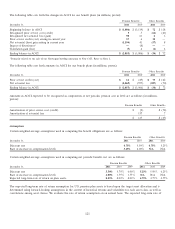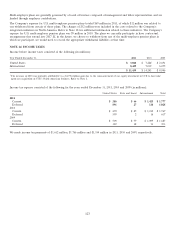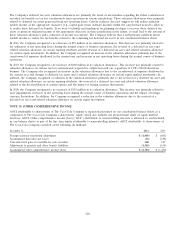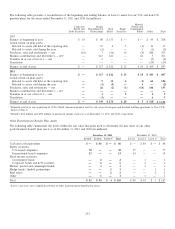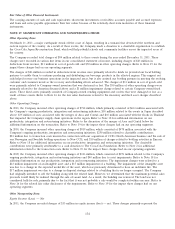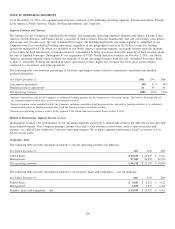Coca Cola 2011 Annual Report Download - page 130
Download and view the complete annual report
Please find page 130 of the 2011 Coca Cola annual report below. You can navigate through the pages in the report by either clicking on the pages listed below, or by using the keyword search tool below to find specific information within the annual report.
The Company’s deferred tax asset valuation allowances are primarily the result of uncertainties regarding the future realization of
recorded tax benefits on tax loss carryforwards from operations in various jurisdictions. These valuation allowances were primarily
related to deferred tax assets generated from net operating losses. Current evidence does not suggest we will realize sufficient
taxable income of the appropriate character (e.g., capital gain versus ordinary income) within the carryforward period to allow us
to realize these deferred tax benefits. If we were to identify and implement tax planning strategies to recover these deferred tax
assets or generate sufficient income of the appropriate character in these jurisdictions in the future, it could lead to the reversal of
these valuation allowances and a reduction of income tax expense. The Company believes that it will generate sufficient future
taxable income to realize the tax benefits related to the remaining net deferred tax assets in our consolidated balance sheets.
In 2011, the Company recognized a net decrease of $91 million in its valuation allowances. This decrease was primarily related to
the utilization of net operating losses during the normal course of business operations, the reversal of a deferred tax asset and
related valuation allowance on certain expiring attributes and the reversal of a deferred tax asset and related valuation allowance
on certain equity investments. In addition, the Company recognized an increase in the valuation allowances primarily due to the
carryforward of expenses disallowed in the current year and increases in net operating losses during the normal course of business
operations.
In 2010, the Company recognized a net increase of $269 million in its valuation allowances. This increase was primarily related to
valuation allowances on various tax loss carryforwards acquired in conjunction with our acquisition of CCE’s North American
business. The Company also recognized an increase in the valuation allowances due to the carryforward of expenses disallowed in
the current year and changes to deferred tax assets and a related valuation allowance on certain equity method investments. In
addition, the Company recognized a reduction in the valuation allowances primarily due to the reversal of a deferred tax asset and
related valuation allowance on certain expiring attributes, the reversal of a deferred tax asset and related valuation allowance
related to the deconsolidation of certain entities and the impact of foreign currency fluctuations.
In 2009, the Company recognized a net increase of $112 million in its valuation allowances. This increase was primarily related to
asset impairments, increases in net operating losses during the normal course of business operations and the impact of foreign
currency fluctuations. In addition, the Company recognized a reduction in the valuation allowances due to the reversal of a
deferred tax asset and related valuation allowance on certain equity investments.
NOTE 15: OTHER COMPREHENSIVE INCOME
AOCI attributable to shareowners of The Coca-Cola Company is separately presented on our consolidated balance sheets as a
component of The Coca-Cola Company’s shareowners’ equity, which also includes our proportionate share of equity method
investees’ AOCI. Other comprehensive income (loss) (‘‘OCI’’) attributable to noncontrolling interests is allocated to, and included
in, our balance sheets as part of the line item equity attributable to noncontrolling interests. AOCI attributable to shareowners of
The Coca-Cola Company consisted of the following (in millions):
December 31, 2011 2010
Foreign currency translation adjustment $ (1,445) $ (805)
Accumulated derivative net losses (53) (198)
Unrealized net gain on available-for-sale securities 160 167
Adjustment to pension and other benefit liabilities (1,365) (614)
Accumulated other comprehensive income (loss) $ (2,703) $ (1,450)
128





